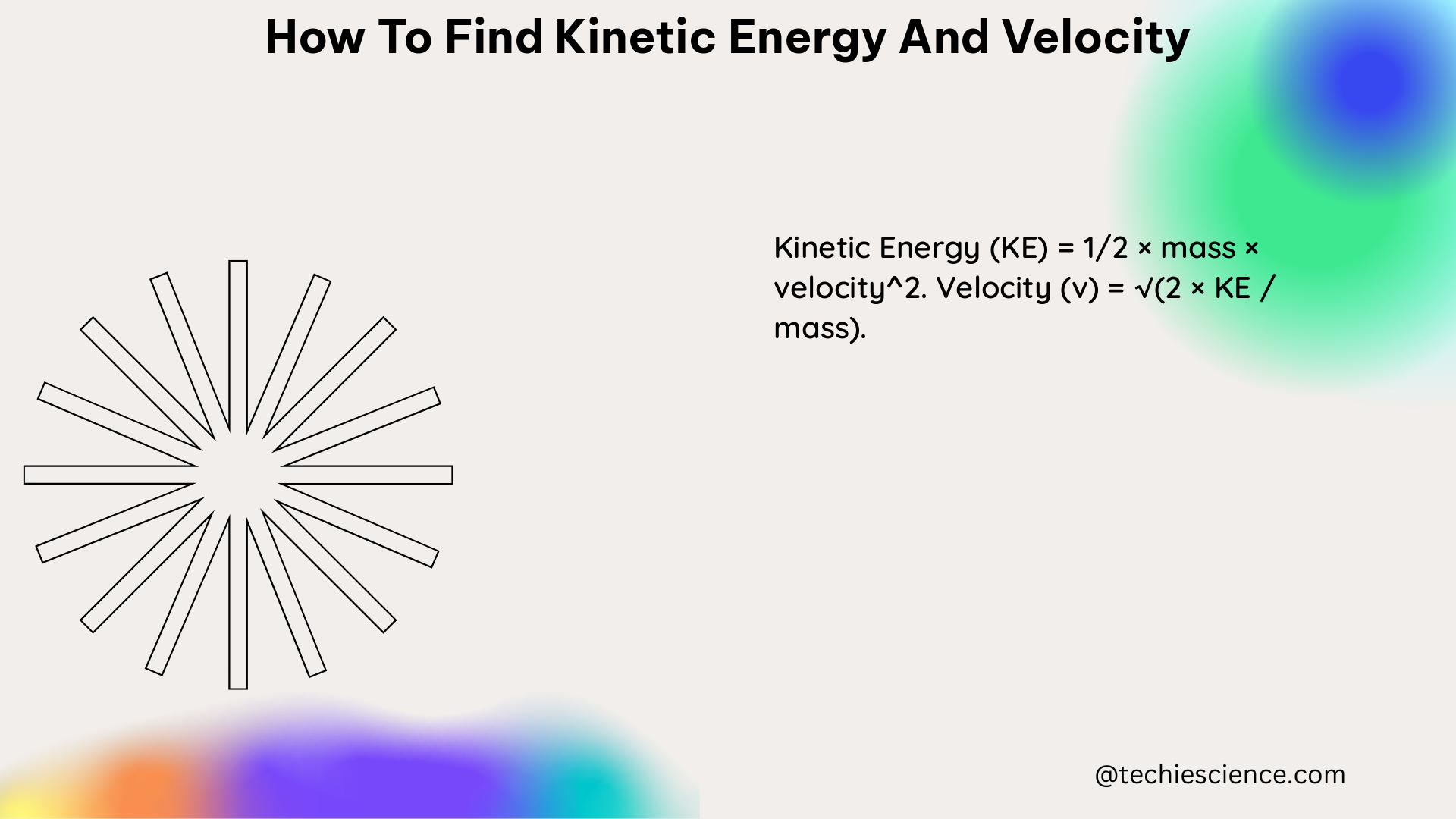Kinetic energy and velocity are fundamental concepts in physics that are crucial for understanding the motion of objects. This comprehensive guide will provide you with a detailed understanding of how to calculate kinetic energy and velocity, including the necessary formulas, measurements, and examples to help you master these concepts.
Understanding Kinetic Energy
Kinetic energy is the energy an object possesses due to its motion. It is directly proportional to the mass of the object and the square of its velocity. The formula for calculating kinetic energy is:
KE = (1/2) * m * v^2
Where:
– KE is the kinetic energy of the object (in Joules)
– m is the mass of the object (in kilograms)
– v is the velocity of the object (in meters per second)
To calculate the kinetic energy of an object, you need to know its mass and velocity.
Measuring Mass
The mass of an object can be measured using a balance or scale. The weight of the object, which is the force of gravity acting on the object, can be converted to mass using the formula:
m = F/a
Where:
– m is the mass of the object (in kilograms)
– F is the force of gravity acting on the object (in Newtons)
– a is the acceleration due to gravity (9.8 m/s^2)
For example, if an object has a weight of 50 Newtons, its mass would be:
m = 50 N / 9.8 m/s^2 = 5.1 kg
Measuring Velocity
There are several methods to measure the velocity of an object:
- Stopwatch and Ruler:
- Measure the time it takes for the object to travel a known distance.
-
Use the formula
v = d/t, wherevis the velocity,dis the distance traveled, andtis the time taken. -
Motion Detector:
- Use a motion detector to measure the distance the object travels over time.
-
Calculate the velocity using the same formula
v = d/t. -
Photogate:
- Use a photogate to measure the time it takes for the object to pass through a small gap.
- Calculate the velocity using the formula
v = d/t, wheredis the width of the gap.
Calculating Kinetic Energy

Once you have the mass and velocity of an object, you can use the formula for kinetic energy to calculate its value.
For example, let’s say you have a car with a mass of 1000 kg and it is moving at a velocity of 20 m/s. To calculate its kinetic energy, you would use the formula:
KE = (1/2) * m * v^2
KE = (1/2) * 1000 kg * (20 m/s)^2
KE = (1/2) * 1000 kg * 400 (m/s)^2
KE = 200,000 Joules
So, the car has a kinetic energy of 200,000 Joules when it is moving at a velocity of 20 m/s.
Practical Applications and Examples
Kinetic energy and velocity are important concepts in various fields, including:
-
Mechanics: Calculating the kinetic energy of moving objects, such as cars, projectiles, or falling objects, can help analyze their motion and predict their behavior.
-
Sports and Athletics: Analyzing the kinetic energy and velocity of athletes, such as sprinters or baseball players, can help coaches and trainers optimize their performance.
-
Engineering: Understanding kinetic energy and velocity is crucial in the design and analysis of mechanical systems, such as engines, turbines, and transportation vehicles.
-
Everyday Life: Calculating the kinetic energy of objects in our daily lives, such as a ball rolling down a hill or a person walking, can help us understand the energy involved in these processes.
Here are some additional examples to illustrate the application of kinetic energy and velocity calculations:
Example 1: A 50 kg skier is moving at a velocity of 15 m/s. Calculate the kinetic energy of the skier.
KE = (1/2) * m * v^2
KE = (1/2) * 50 kg * (15 m/s)^2
KE = (1/2) * 50 kg * 225 (m/s)^2
KE = 5,625 Joules
Example 2: A 2 kg baseball is thrown at a velocity of 30 m/s. Calculate the kinetic energy of the baseball.
KE = (1/2) * m * v^2
KE = (1/2) * 2 kg * (30 m/s)^2
KE = (1/2) * 2 kg * 900 (m/s)^2
KE = 900 Joules
Example 3: A 1000 kg car is traveling at a velocity of 60 m/s. Calculate the kinetic energy of the car.
KE = (1/2) * m * v^2
KE = (1/2) * 1000 kg * (60 m/s)^2
KE = (1/2) * 1000 kg * 3,600 (m/s)^2
KE = 1,800,000 Joules
These examples demonstrate the application of the kinetic energy formula and the importance of accurately measuring the mass and velocity of an object to determine its kinetic energy.
Conclusion
In this comprehensive guide, we have explored the concepts of kinetic energy and velocity, including the necessary formulas, measurements, and practical applications. By understanding these fundamental principles, you can effectively calculate the kinetic energy and velocity of various objects, which is crucial in fields such as mechanics, sports, engineering, and everyday life. Remember to practice these calculations and apply the concepts to real-world scenarios to deepen your understanding of this important topic in physics.
Reference:
- Kinetic Energy and Velocity Lab – Arbor Scientific
- Teaching kinetic energy as an observable quantity – IOPscience
- Kinetic Energy Calculator – CalculatorSoup

The lambdageeks.com Core SME Team is a group of experienced subject matter experts from diverse scientific and technical fields including Physics, Chemistry, Technology,Electronics & Electrical Engineering, Automotive, Mechanical Engineering. Our team collaborates to create high-quality, well-researched articles on a wide range of science and technology topics for the lambdageeks.com website.
All Our Senior SME are having more than 7 Years of experience in the respective fields . They are either Working Industry Professionals or assocaited With different Universities. Refer Our Authors Page to get to know About our Core SMEs.